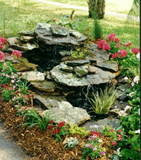
Most pondless waterfalls are holes in the ground filled with rocks or a box that makes the sound echo. All nice and all with their own problems. Yesterday I decided to make my own pondless waterfall in the front yard.
It could be a pond with fish and plants, but it is really small, so I now have my own mini pondless waterfall.
Here's how I did it: I bought a 3' in diameter x 2' deep Rubbermaid horse watering trough at a feed and seed store. It cost about 40 bucks. I had a pump lying around from my active pond building days. It's a 700 gph Little Giant submersible. I also had rocks in the yard, saved from my pre Katrina pond and moved to this house from the one that we had to bulldoze.
First was a hole in the ground. I did not bury the horse trough all the way, but left about 6" above the ground. It's easier to deal with that way, easier to keep level and doing it like that avoids any run off. Also with our water table so high, digging a 2' deep hole would find me in the water before I got all the way down.
After you dig the hole, put in the horse trough and fill it with water. If you don't it will rise like the phoenix while you are leveling it. Add kiddie play sand around the edges to give a solid surface to hold the trough. Use water to pack down the sand. As you doing that, get the trough as level as you can. You will cantilever rocks over the top later, so you don't have to be perfect here.
Start piling up flat rocks to hide the sides of the trough that is above ground. Doing this will make the pond look natural. Save a spot for the waterfall.
Attach flexible tubing to the pump and then T off with a hard plastic T fitting like plumbers use.
Put the pump in the water.
Now build your waterfall on one edge of the trough. Use a large flat rock for the bottom, put a few thicker rocks on top and add another rock on top of those. That's about as high as you can get because you don't want water splashing out.
Place the two hoses on the top of the waterfall. Maybe one hose on each level. Whatever pleases you. Put rocks the same thickness as the hoses on either side and a rock on top to keep them where you put them.
Now arrange the hoses so no water slides off the back or over the sides and out of the trough.
Hide the hoses in the back of the falls with rocks or plant material.
Use swimming pool chlorine to keep the water clear.
There, you have it and it only took a few hours. This one took me about 5 hours yesterday. I am moving a bit slow this morning.
To find more pond information, go to pondlady.com
And to meet a great community of gardeners, join us at Gardeners Gumbo



















